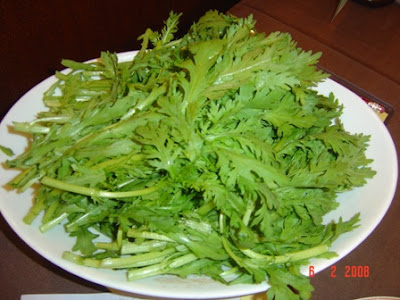 Is it dinner time yet?
Is it dinner time yet?Hotpot is common in most Asian cultures. For Chinese it is hou-gou, Japanese calls it shabu-shabu, or known as lau to the Vietnamese. Koreans have their version of hotpot too, i'm not sure what it's called (is it shin sul ro?). However they all share a common theme of a shared pot of boiling broth on a burner, fresh uncooked ingredients, This cook-at-the-table recipe is not only easy to make, it is also alot of fun to have a group of family and/or friends gathering around the table over dinner. Hotpot is one of my favorite dinner choice for colder evenings, since it is easy to prepare, hot and slurpy, healthy as I want it to be, and we can take our time eating while chitchating.
Hot pots come in many shapes and size. More popular for home use is the kind we have (see picture above), electrical pot with dial setting for on/off and temperature control. This pot can also be used as a deep fryer.
Broth:
The broth is an important aspect of hotpots. Many hotpot restaurants make their own broth and guard the recipe as it can be the secret to their success, people do come to a certain restaurant for their flavorful broth. A good hotpot restaurant in Monterey Park that we love to take families there when they visit is called Little Fat Lamb (literal translation from its Chinese name). They use a flavorful and super spicy broth that's made from 60 different herbs, the kind of broth that makes your stomach warm.
At home, I make a simple broth: water, add a can of chicken broth, also add 1 daikon (cut into big chunks about 1-2 inch length). Let the broth boil. During the course of dinner, you may need to add more broth (I usually boil water seperately, and add to the hotpot as needed)

Ingredients:
Whatever your favorites are. Really, anything goes! that's what great about hot pots.
Typical main dishes are:
+ Thinly sliced beef and/or lamb
+ Fresh seafoods:
- shrimps (usually unpeeled, heads on)
- oysters
- clams
- live fish filet (it is really worth it to get a live fish like tilapia, then filet it. A couple times we got the already-filet fish from the market it turned out not so fresh and it was a waste).
+ Fish/shrimp/squid/pork balls
+ Japanese fried tempura (fish or shrimp paste cake)
Typical vegetables are:
+ Tofu - the white kind, non-fried, is better
+ Assorted mushrooms
+ Spinach, lettuce
+ Other seasonal greens
+ Napa cabbage
+ Corn
+ Taro
+ This vegie is our favorite for hotpot - it's called Tan O in Vietnamese, what's its English name?
It only took me about 30 min to wash/clean and setup the hotpot table.
The most popular dipping sauce for hotpot (at least the chinese style hotpot) is sacha. For home use, I buy the Lee Kum Kee sacha sauce in a jar, or else just use a good light soysauce.






2 comments:
It's like you've read my mind - I've been thinking about hotpot meal. It's not something in Filipino cuisine but I've had it in various Asian cuisines, the first time being with our Cambodian friends in high school. I love the idea of sharing the pot and having fresh ingredients that you cook as you eat!
Thanks for your comment on my Mahnomin Porridge post! In answer to your question, I think milk can be used instead of heavy cream, although the texture won't be, well, creamy! Wild rice doesn't have the same texture as 'real' rice like jasmine or glutinous/sweet rice. If you'd like to have it thick using milk, then I'd suggest sprinkling some arrowroot flour toward the end of cooking! Hope this helps!
Tangled Noodle: thanks. Oh yea, i forget about the texture of the wild rice compared to regular rice. I see why the cream can make the difference here (besides the creamier taste).
Post a Comment